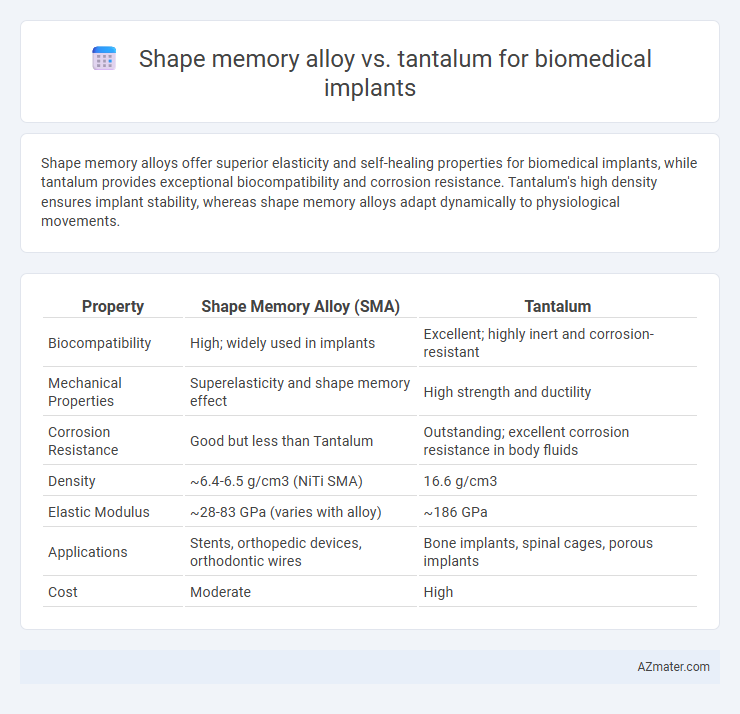Shape memory alloys offer superior elasticity and self-healing properties for biomedical implants, while tantalum provides exceptional biocompatibility and corrosion resistance. Tantalum's high density ensures implant stability, whereas shape memory alloys adapt dynamically to physiological movements.
Table of Comparison
| Property | Shape Memory Alloy (SMA) | Tantalum |
|---|---|---|
| Biocompatibility | High; widely used in implants | Excellent; highly inert and corrosion-resistant |
| Mechanical Properties | Superelasticity and shape memory effect | High strength and ductility |
| Corrosion Resistance | Good but less than Tantalum | Outstanding; excellent corrosion resistance in body fluids |
| Density | ~6.4-6.5 g/cm3 (NiTi SMA) | 16.6 g/cm3 |
| Elastic Modulus | ~28-83 GPa (varies with alloy) | ~186 GPa |
| Applications | Stents, orthopedic devices, orthodontic wires | Bone implants, spinal cages, porous implants |
| Cost | Moderate | High |
Introduction to Biomedical Implant Materials
Shape memory alloys (SMAs) and tantalum are prominent materials in biomedical implants due to their unique mechanical and biocompatible properties. SMAs, such as NiTi (Nitinol), exhibit superelasticity and shape memory effects, enabling dynamic response to physiological conditions, while tantalum offers exceptional corrosion resistance and osseointegration, crucial for implant stability. The selection between SMA and tantalum depends on the specific implant application, balancing factors like mechanical flexibility, biocompatibility, and long-term durability in the human body.
Overview of Shape Memory Alloys
Shape memory alloys (SMAs), such as Nitinol, exhibit unique properties like superelasticity and the ability to return to their original shape after deformation, making them highly suitable for biomedical implants. Their biocompatibility, corrosion resistance, and excellent fatigue behavior provide significant advantages over traditional implant materials, including tantalum. SMAs are extensively used in cardiovascular stents, orthopedic devices, and orthodontic applications due to their adaptability and mechanical performance in dynamic physiological environments.
Tantalum: Properties and Biomedical Applications
Tantalum exhibits exceptional biocompatibility, corrosion resistance, and osteointegration, making it highly suitable for biomedical implants such as orthopedic joint replacements, dental implants, and vascular stents. Its high density and modulus of elasticity closely match human bone, reducing stress shielding and promoting long-term stability. Compared to shape memory alloys, tantalum's inertness and minimal ion release contribute to enhanced patient safety and implant longevity in demanding physiological environments.
Biocompatibility: Shape Memory Alloy vs Tantalum
Shape memory alloys (SMAs) like Nitinol exhibit excellent biocompatibility due to their corrosion resistance and ability to undergo reversible deformation, minimizing tissue damage and inflammatory responses in biomedical implants. Tantalum demonstrates superior biocompatibility with exceptional corrosion resistance and is highly osteoconductive, promoting better bone integration in orthopedic applications. Both materials possess unique advantages, but tantalum's bioinertness and high compatibility with bone tissue often make it preferable for load-bearing implants requiring long-term stability.
Mechanical Properties Comparison
Shape memory alloys (SMAs), such as Nitinol, exhibit exceptional superelasticity and high fatigue resistance, making them ideal for dynamic biomedical implants that require flexibility and repeated deformation. In contrast, tantalum demonstrates superior biocompatibility and corrosion resistance with excellent strength and stiffness but lacks the unique pseudoelastic behavior of SMAs. The mechanical properties of SMAs enable implants to recover their shape after deformation, while tantalum provides long-term structural stability in load-bearing applications.
Corrosion Resistance in the Human Body
Shape memory alloys, particularly nickel-titanium (Nitinol), exhibit excellent corrosion resistance in the human body due to their stable oxide layer that prevents ion release and maintains biocompatibility. Tantalum also demonstrates superior corrosion resistance by forming a dense, inert oxide film that resists degradation and promotes osseointegration in implant applications. Comparative studies show that while both materials offer robust corrosion resistance, tantalum's bio-inertness and resistance to localized corrosion make it highly favorable for long-term biomedical implants exposed to aggressive physiological environments.
Imaging Compatibility and Visibility
Shape memory alloys (SMAs) like Nitinol exhibit excellent biocompatibility and mechanical properties but pose challenges in medical imaging due to their radiopaque nature, which can cause significant artifacts in MRI and CT scans, hindering tumor or tissue visualization. In contrast, tantalum demonstrates superior imaging compatibility with minimal artifacts across X-ray, CT, and MRI modalities, offering enhanced implant visibility critical for precise post-operative assessment and long-term monitoring. The high radiodensity of tantalum ensures clear delineation without signal distortion, making it a preferred choice for biomedical implants in applications where imaging clarity is paramount.
Long-term Performance and Durability
Shape memory alloys (SMAs), such as Nitinol, exhibit exceptional biocompatibility and cyclic fatigue resistance, making them ideal for dynamic biomedical implants that require flexibility and shape recovery over extended periods. Tantalum offers superior corrosion resistance and osteointegration, ensuring long-term stability and durability in load-bearing orthopedic implants with minimal risk of ion release or inflammatory response. The choice between SMA and tantalum depends on the implant's functional demands, with SMAs favored for applications needing elastic deformation and tantalum preferred for permanent structural support and bone integration.
Clinical Outcomes and Case Studies
Shape memory alloys, particularly Nitinol, demonstrate superior biocompatibility and flexibility in biomedical implants, with numerous clinical case studies highlighting excellent long-term patient outcomes in cardiovascular stents and orthopedic devices. Tantalum implants show outstanding corrosion resistance and osseointegration, frequently resulting in successful outcomes for bone grafts and joint replacements in clinical trials. Comparative studies reveal that while Nitinol offers dynamic adaptability to physiological movements, tantalum provides enhanced structural stability and longevity in load-bearing applications.
Future Trends in Biomedical Implants: Alloy Innovations vs Tantalum
Future trends in biomedical implants highlight significant advancements in shape memory alloys (SMAs) such as NiTi, which exhibit exceptional biocompatibility, superelasticity, and fatigue resistance, enabling dynamic and minimally invasive applications. Tantalum remains valued for its outstanding corrosion resistance, osseointegration, and radiopacity, making it ideal for load-bearing implants and bone scaffolds. Emerging research focuses on hybrid materials combining alloy innovations with tantalum's stability to create implants with enhanced mechanical properties and biological performance.

Infographic: Shape memory alloy vs Tantalum for Biomedical implant
 azmater.com
azmater.com